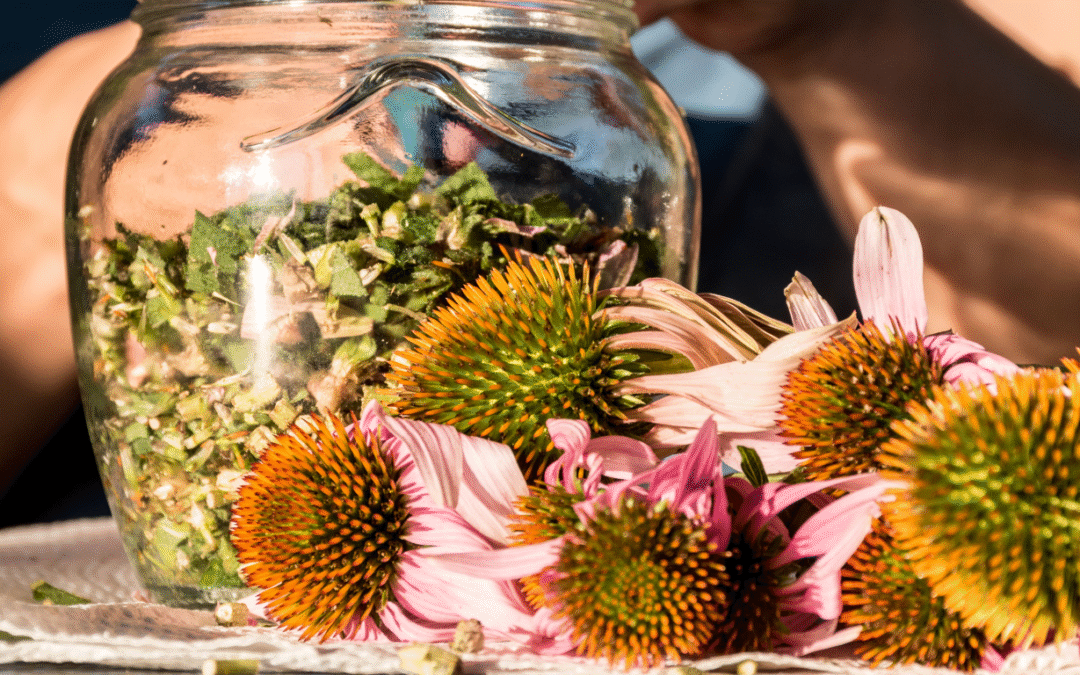Spring has sprung! If you’re like me, you’ve been elbows deep in seed catalogs and garden plans most of the winter, just waiting for the time when you can start spring planting. That time is HERE, my beautiful backyard beauties. And for me, echinacea is at the top of my gardening wishlist.
This year, I’ll be planting more perennials to expand my home apothecary. Granted, I can get many of the following native Pennsylvania plants, roots and flowers right at Wholly Holistic from their loose herb section. But, there’s something about growing it myself that makes me feel like I’ve honored my ancestors, my earth and my spirit.
This blog is the first in our Grow Your Garden Apothecary Series! I’m going to walk you through must-have native Pennsylvania plants that you can easily grow, harvest and preserve to expand your home apothecary. Each of the plants I’ve chosen have important health benefits you can have on hand. For more about what to keep stocked in your home apothecary, read my blog: 5 Ways to Build Immunity Naturally.
Let’s get started!
Grow Echinacea (Coneflower) for Immune Support and More
Need flower power? Echinacea is it! Just about every blend we carry for immune support has echinacea in it. Commonly known as coneflower, echinacea (Echinacea purpurea) has been used as an herbal remedy for hundreds of years to prevent colds, reduce inflammation, relieve anxiety and more.
Native to Pennsylvania, echinacea comes in an addictively beautiful wide variety of plants, most commonly purple coneflower. I’m a huge collector of these drought resistant perennials and have at least 7 varieties in my yard. My favorite has to be the Green Twister, but honestly, they’re all tied for first place in my heart.
Medicinal Benefits
The plant is popular for its cold and flu fighting properties and can also help treat pain, inflammation, migraines, lower blood sugar and more. The flowers and roots contain flavonoids, cichoric acid and rosmarinic acid which help protect against oxidative stress that can lead to diabetes and heart disease.
Cautions
Since echinacea stimulates your immune system, take caution if you have an immune-related health issue, such as HIV/AIDS, or if you have an autoimmune disorder or are taking immune-suppresant drugs. Otherwise, echinacea is generally safe for use with very few side effects reported.
How to Grow and Harvest Echinacea (Coneflower)
Coneflower is so easy to grow! Whether it’s from seed or a starter plant, you really can’t go wrong. I usually buy mine as established plants because I get sucked into their beauty at the nursery. But, seeds are much more cost effective and are just as easy to work with.
Planting an Established Plant
Coneflower is so common that you’ll find it at any local Pennsylvania nursery in multiple varieties. Choose a sunny location in your yard with well-drained, average soil in either the spring or the fall. Dig a hole twice as wide and deep as the roots, add a little flower fertilizer or chicken/goat/rabbit manure (optional because coneflower are very tolerant of poor and average soil) and water regularly until established.
Planting from Seed
To grow the plant from seed, just use the above instructions for where to place them and sow the seeds about ¼” deep. Water daily, even twice a day if particularly hot, until established. Thin the seedlings to be about a foot apart.
Harvesting Your Plants Seeds and Resowing
You read that right! You can collect the seeds from your coneflowers in the fall and replant them. Wait for the plants to completely die back and the seed pods to dry in the sun. Or, snip the flowers off when they start to die and place the flower heads on screens to allow the seeds to dry out. Either plant them that fall or wait for the spring.
I like to leave a good amount of the seed pods for the birds, if for no other reason than to watch them hang upside down and munch on the delicious seed treat!
Dividing and Replanting Established Plants
I typically let my plants grow for a couple years before dividing and replanting them. Then, I take a clean, sharp shovel and split the plant into two or three smaller plants. Once split, I dig up the roots carefully and plant them using the instructions above for established plants.
How to Harvest and Use Echinacea in Your Home Apothecary
Every part of the echinacea plant, from roots to petals, are edible and good for you!
Roots: Nutrient-rich and can be used in teas and soups
Leaves: Can be used in salads and teas
Flowers: Can be used in teas and jellies
Harvesting and Preserving the Flowers and Leaves
Harvest the flowers and leaves by cutting the stems above the lowest leaf pairs. You can remove the flowers and leaves to use separately or dry the entire stems. To do so, lay them out flat in a sheltered, dry location, or hang them in bunches. When they’re completely dry, remove the dried flower petals and leaves and store in sealed containers.
You can use the dried flower petals and leaves in:
- Herbal teas
- Soups
- Desserts and jellies
- Vinegars
- Tinctures
Harvesting and Preserving the Seeds for Consumption
Technically? You can eat the seeds from echinacea plants, although some warn about their toxicity, so I typically don’t eat them and just let the birds enjoy them. If you do choose to eat them, wash the seeds carefully and dry them completely. Once dry, roast them gently in a pan with flavorings.
Harvesting and Preserving the Roots
It’s best to wait at least 2 years before harvesting coneflower roots. This is because the plant needs time to create lots of roots to spare and still survive after you harvest some of them. To harvest, dig up the plants gently and set the plant on its side to view the root system. You can cut back about half of the roots and replant the plant. Keep in mind, sometimes this kind of disruption can kill the plant but echinacea is very hardy so the risk of this is minimal.
Clean the cut roots really well and cut them into smaller pieces. Let them dry completely, which can take a few weeks. Then store them in an airtight container.
You can also eat the roots raw! Try this immunity-boosting miso soup with fresh echinacea roots, mushrooms and more.
Two Recipes to Try at Home
Ginger, Lemon and Echinacea Tea
Try this herbal tea recipe to help with inflammation and digestion.
What you need:
2 cups boiling water
1 teaspoon dried echinacea flower petals (or roots)
1 teaspoon finely chopped fresh or dried ginger root
Juice of 1 lemon, freshly squeezed
1 teaspoon honey (or more to taste)
What you do:
In a teapot, pour the boiling water over the echinacea and chopped ginger. Cover and steep for 10-15 minutes, longer if you would like it stronger. Add lemon juice and honey and stir to mix. Strain and pour into 2 mugs. Serve warm and enjoy!
You can also eat the fresh petals and leaves! Use them in salads, garnishes and more. Check out this blog for a basic flower petal jelly recipe you can use with ANY flower.
How to Make Your Own Echinacea Tincture
Making your own echinacea tincture from the plants in your yard is really simple. Once you’ve done it, you’ll be eyeing up the other medicinal plants you’ve always had (bee balm, calendula and more) and growing your stash by leaps and bounds.
What you need:
A clean glass container with an airtight lid
Knife
Butter knife or chopstick
A bowl
The highest alcohol content you can find in vodka. The amount of vodka you’ll need will depend on how big your jar is and how much you’re going to make.
A good-sized clump of Echinacea purpurea (purple coneflower) that’s older than 2 years and in peak bloom – leaves and flowers are lush and vibrant.
Fine mesh strainer or muslin
Measuring cup with pour spout
Amber or blue jars
What you do:
Start by harvesting your echinacea. Choose a cluster of flowers, stems and leaves that have a good, solid chunk of roots to them. The more roots, the better properties your tincture will have.
Once you’ve split the plant and taken the portion you want, replant the rest and say a thank you to the plant for keeping you healthy.
Wash everything really well. If the roots are caked in mud, you might try to soak them to get the excess dirt off. Discard and compost any dead or damaged parts.
Chop everything – flowers, leaves, stems, roots – very fine. The finer the ingredients are, the stronger the tincture will be.
Label your jar and date it. Add the chopped mixture to the jar and fill with vodka until the vodka just covers the plant mixture. Give the jar a little shake to settle the air bubbles. Use the butter knife or chop stick to poke the plant mixture beneath the vodka. You can add more vodka if you need to, but keep in mind that more vodka makes for a weaker mixture.
Add the airtight lid and stash the jar away from direct light, but nearby where you can easily see it over the next 6 weeks. For the first few weeks, give the jar a gentle shake every other day. If the plant mixture rises above the vodka, top it with vodka. After 6 weeks, test a drop on your tongue to see if it’s ready – if it’s a little tingly on your tongue, it’s good to go. If not, leave it for another week and try again.
Strain the mixture through the fine mesh strainer or muslin and into a measuring cup that has a pour spout. Press out as much liquid as you can. Add the liquid to the amber or blue jars, seal with airtight lids and label with the name of the tincture and date.
Most tinctures like this will keep at least 2 years, if kept in a cool, dark place.
To use, add 1-2 drops to any drink, 1-3 times a day or as needed.
We Have Echinacea at Wholly Holistic!
At Wholly Holistic, we have echinacea in all forms – loose, tinctures, capsules, teas, and more. We’re happy to help you meet your health goals. Stop in, call or message us today to ask all your questions and to schedule a health coaching appointment with one of our certified practitioners.
See you at the shop!
Sources
National Center for Complementary and and Integrative Health, November 2024: Echinacea Facts
Health.com, September 2023: Health Benefits of Echinacea
Healthline, March 2023: Echinacea: Benefits, Uses, Side Effects, and Dosage
The Old Farmers Almanac: How to Grow Coneflowers: The Complete Echinacea Flower Guide
Gardening Know How: How To Harvest Echinacea Flowers, Seeds And Roots
Kathy Irvine’s Edible Backyard: How To Make Echinacea Tincture
Southern Seed Garlic: How to Make an Echinacea “Super Tincture”

